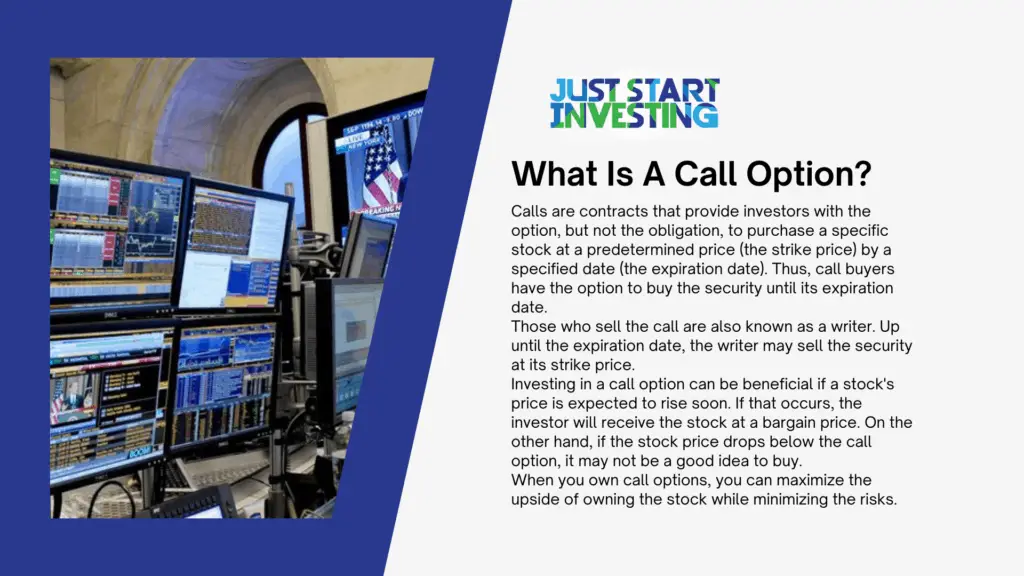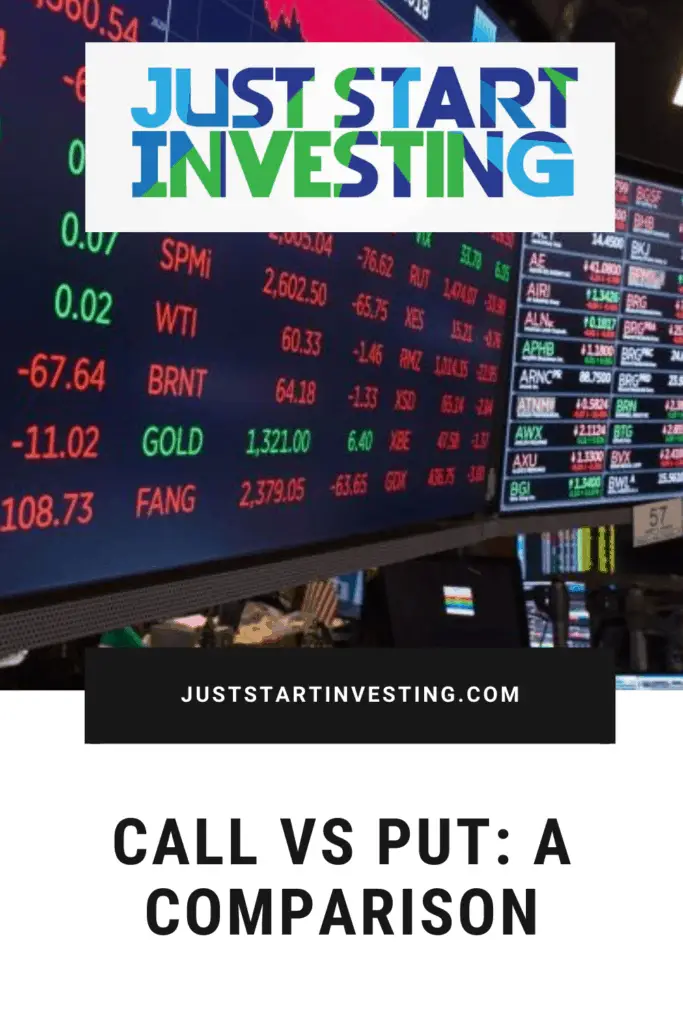At times, it may make more sense to choose a call option, while a put may be more suitable at other times. No matter what your circumstances may be, it is important to understand the difference between call and put.
For stocks and other investments, there are two types of options contracts: call and put.
When deciding which option to use, you need to know its characteristics. There are both “right” and “wrong” ways to use things like everything in life. The “right” way to use call and put options is beyond the scope of this article, but suffice to say that you’ll never maximize their potential if you don’t understand their characteristics.
So what are the differences between them?
What Is A Call Option
Calls are contracts that provide investors with the option, but not the obligation, to purchase a specific stock at a predetermined price (the strike price) by a specified date (the expiration date). Thus, call buyers have the option to buy the security until its expiration date.
Those who sell the call are also known as a writer. Up until the expiration date, the writer may sell the security at its strike price.
Investing in a call option can be beneficial if a stock’s price is expected to rise soon. If that occurs, the investor will receive the stock at a bargain price. On the other hand, if the stock price drops below the call option, it may not be a good idea to buy.
When you own call options, you can maximize the upside of owning the stock while minimizing the risks.

How does a call option work?
Call options are contracts tied to stocks. To buy a call option, you have to pay a premium. An agreement like this allows you to buy the stock at a set price, referred to as the strike price, at any time until it expires.
There is no obligation for you to execute the option. It is possible to sell the contract itself for a profit or execute it if the stock price increases sufficiently. However, if it doesn’t, you will only lose the premium you paid.
A call option’s break-even point is calculated by adding the strike price and premium. When you hold a call option, you can calculate your profit or loss at any moment by subtracting the current price from the breakeven point.
For example, imagine that you’re bullish, believing that a stock’s price will go higher on a certain stock that’s trading at $150 per share. The strike price of the call option is $170, and it expires in six months. Each share of this call option costs $15. So if the options contract covers 100 shares, the total cost is $1,500.
Considering the $170 strike price and the $15 premium, $185 is the breakeven point. Your profit will be $10 per share, or $1,000 total if the stock reaches a price of $195. A loss of $10 per share would occur in another scenario if it only went to $175. Thus, the maximum loss you could sustain is the $1,500 premium you paid.
What Is A Put Option
Alternatively, investors purchasing a put option have the right to sell a stock up until its expiration date at a stipulated price. Then, as long as the time period is still active, the investor who bought the put option can sell the stock to the writer for the agreed-upon price. However, this is not a binding agreement.
Shares can be hedged against a drop in price by using put options. Consequently, even if a put option declines, the investor will not incur a further loss. In addition, the investor could benefit from a bear market or dip in stock prices as well.
How does a put option work?
Just as call options, put options are contracts tied to stocks. A contract gives you the right to sell stocks at a predetermined price. Similarly, the contract can be executed at any time until its expiration date.
Put options can be sold for a profit if the stock’s price drops enough. However, unless the asset’s price drops significantly, you’re not obligated to execute the contract.
The breakeven point for a put option is the difference between the strike price and the premium.
Consider an example where a company’s stock trades for $500 per share. So you buy a put option with a $450 strike price and a 3-month expiration date, thinking it’s overvalued. In total, the contract costs $1,000, which is $10 per share.
If the strike price is $450 and the premium is $10, the breakeven point is $440. Your put option will return you $40 per share ($4,000 total) if the company plummets to $400. If the stock does not drop down to $450, you would have no choice but to let the option expire and eat the cost.
Call vs Put Option
To sum up, by buying a call, an investor hopes to profit when the price of a stock increases. In contrast, the writer hopes the stock price will fall or at least remain the same so they will not have to exercise the option.
Alternatively, with a put option, investors profit when the stock price drops. As the stock drops in value, the put increases. In other words, the investor wants the stock price to decline, while the writer wants the price to rise or remain the same, so they won’t be forced to exercise the trade.
Call options can be bought by paying a premium to the seller or writer. However, the market margin money does not have to be paid before the purchase. Put traders, though, must deposit margin with the market when they sell put options. By doing so, the premium can be kept on the put option.
As far as profitability is concerned, call options have unlimited profit potential because the price of a stock cannot be capped. Put options, however, have limited profit potential since the price of the stock cannot fall below zero.
Investing in call options or put options is inherently risky and is not recommended for retail investors. However, those who believe the market will move, are willing to engage in risk-taking, and are prepared to invest in stocks could reap significant rewards. If you’re unsure of what trading level you’d fit into or how much risk you’re comfortable with, it may be time to consult with a financial professional.
Put / Call Option Ratio
Put-call ratios illustrate how much open interest there is on put options versus call options. A put-call ratio can measure stock, index, or market sentiment. Put contracts generally exceed call contracts when the put-call ratio is more significant than one, which is considered bearish. Alternatively, a put-call ratio less than one is deemed to be bullish.
You can check out the research chart surrounding this ratio on the following link!
We have also provided a few links to some of the top call/put charts for stocks:
- TSLA Put/Call Ratio
- AAPL Put/Call Ratio
- SPY Put/Call Ratio
- SPX Put/Call Ratio
- AAL Put/Call Ratio
- AMZN Put/Call Ratio
- MSFT Put/Call Ratio
- GOOGL Put/Call Ratio
- BA Put/Call Ratio
- DIS Put/Call Ratio
- DAL Put/Call Ratio
- KO Put/Call Ratio
- AMD Put/Call Ratio
- NFLX Put/Call Ratio
- BABA Put/Call Ratio
An indicator of market sentiment, the SPX Put/Call Ratio measures sentiment toward the stock market. The ratio is calculated by dividing the price of put options on the S&P 500 by the price of call options. Put/call ratios higher than the overall market can signify fear, while call/put ratios lower can indicate confidence in the market.
As an example, due to market fears stemming from various global economic concerns, such as the slowdown in Chinese GDP growth and the default of the Greek government, the Put-Call ratio in 2015 reached as high as 3.77.
SPX Put/Call Ratio is currently at 2.05, down from 1.67 one year ago and unchanged from the previous market day. From one year ago, this is an increase of 22.75%.
On this link, you can dive deeper into this data and better understand the numbers!
In addition, presented below is the most recent information on the various types of call/put ratios gathered this year:
| RATIOS | |
| TOTAL PUT/CALL RATIO | 1.00 |
| INDEX PUT/CALL RATIO | 2.01 |
| EXCHANGE-TRADED PRODUCTS PUT/CALL RATIO | 1.09 |
| EQUITY PUT/CALL RATIO | 0.57 |
| CBOE VOLATILITY INDEX (VIX) PUT/CALL RATIO | 1.96 |
| SPX + SPXW PUT/CALL RATIO | 2.05 |
| OEX PUT/CALL RATIO | 1.45 |
| MRUT PUT/CALL RATIO | 2.57 |
Ratio data collected by the Cboe Trade Desk
Risks of Call vs. Put Options
Call vs Put: Which one prevails?
One of the main risks of a call option is that the stock price may only increase slightly. Losing money on an investment is possible in this case. Stocks that do not cover the cost of the premium may yield minimal returns.
With a put option, your portfolio’s risk is effectively managed.
Depending on which options an investor chooses to purchase, options trading can become very complex.
Both call and put options risk expiring worthless when the stock fails to reach the breakeven point. In addition, as explained previously, you lose the amount paid for the premium.
Additionally, you can sell call and put options, which means that another party makes a payment for the options contract. The risk of marketing calls and puts is greater than that of buying them since it carries a greater potential loss. You are responsible for passing the breakeven point by fulfilling the contract, and the buyer exercises the option.
Buying options give you a clear understanding of your risk profile from the beginning. Options contracts are therefore safer than other leveraged instruments such as futures contracts.
Nonetheless, when it comes to options, there is a greater risk of coming out empty-handed than when it comes to selling stocks directly.
The only thing you need to know when investing in stocks is whether they will rise or fall. However, if you are trading options, you must predict three things correctly:
- In what direction the stock is likely to move.
- How much will the stock move?
- Stock movement over time.
Your options contract won’t be worth anything if you’re wrong about any of them. Despite the potential for greater returns, options are harder to market successfully.
Call and put options can be challenging to trade successfully, but they can significantly increase your returns. Considering that, they can serve as a valuable addition to a balanced portfolio.
So, examine the numbers carefully before investing in options, and take a well-calculated risk to improve your returns!
Want to learn more about investing? Check out these articles:
- Implied vs Realized Volatility: Ultimate Showdown
- What is Margin Trading: A Beginners Guide
- Stock Market Crash 2021: Ultimate Predictions

Just Start Investing is a personal finance website that makes investing easy. Learn the simple strategies to start investing today, as well as ways to optimize your credit cards, banking, and budget. Just Start Investing has been featured on Business Insider, Forbes, and US News & World Report, among other major publications for its easy-to-follow writing.
